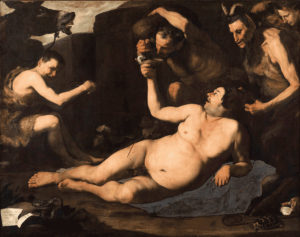The city of Naples, Italy, is known for a great many things: pizza, ice cream, Enrico Caruso, Sophia Loren, a dialect that’s so distinctive that people from other parts of the country need it translated into Italian. In art history, however, it has often been overshadowed by the clean lines and draftsmanship of Florence, the color and sensuality of Venice, and the papal power of Rome. The Kimbell Art Museum’s current exhibit, Flesh and Blood, aims a spotlight at the artists that this port city in Campania was able to attract during the Renaissance and the Baroque eras.
The exhibit begins with Alexandre Dounouy’s landscape that takes in the palace where the Museo di Capodimonte (the name means “hilltop”) is now held. It’s from here that the art treasures were lent to the Seattle Art Museum last fall and now here. The tranquil painting is an appropriate place to begin, but it is also somewhat misleading because the paintings in the show are of decidedly human bodies. These aren’t the fleshy nudes that the Kimbell focused on in its recent Renoir show, either. The skin tones are frequently mottled by blood, as in Caravaggio’s “The Flagellation of Christ,” a late addition to the show that was not displayed in Seattle. Caravaggio fled Rome after killing a man and landed in Naples, where he was commissioned to paint the scene for the church of San Domenico Maggiore. The artist’s familiar theatricality comes through in Christ’s twisted pose, necessitated by two soldiers who are brutalizing him, and the light source shining directly above him. Has anyone painted the color black as vividly as Caravaggio did? His sojourn in the city did much to influence the Neapolitan artists who came after him.
The city’s power was greatly increased by Alessandro Farnese, who became Pope Paul III and installed his grandson and namesake in the Catholic Church there. The exhibit boasts two portraits of the elder Farnese by famous painters. Raphael’s portrait of Farnese was done when the subject was a cardinal in his early 40s, showing off the artist’s clean outlines and the bright red of the cardinal’s robes. Titian’s portrait, on the other hand, shows the pope in his late 70s, with the pontiff’s maroon robes blending in with the dark background. That the same man was able to command pictures from two such great artists testifies to the church’s financial power, and the juxtaposition of two remarkable paintings brings that home. Titian’s painting of Danaë is also on display, a work that originated as a nude portrait of the younger Farnese’s mistress and had to be disguised as a mythological picture for the sake of the cardinal’s reputation.
Artemisia Gentileschi’s “Judith Beheading Holofernes” is one of the more striking paintings in the exhibit, even if you don’t know the backstory. The daughter of a renowned Roman artist, she was raped at age 17 by one of her father’s students, who then refused to marry her to redeem her reputation. Her rich and well-connected father brought charges against him, and the resulting seven-month trial included Artemisia being tortured and given a gynecological examination in front of the judges. It ended with a guilty verdict that was overturned by the accused’s personal friend, the pope. This incident, while it definitely turned Gentileschi toward violent subject matter, also tended to obscure her remarkable skills with the brush. She painted more than one version of the Biblical story of the Israelite Judith decapitating the enemy general after plying him with alcohol. The version in the Uffizi Gallery (which has her wearing a yellow dress) is arguably the more famous one, but the one in the Kimbell (which has her in a blue dress) is no less blunt in its depiction of Holofernes’ blood spurting out of his neck as Judith and her servant hold the man down, the former doing the honors with a knife.
The city of Naples became part of the Spanish Empire at the beginning of the 16th century and remained so for more than 200 years. The Spaniards brought numerous cultural influences with them (including undesirable ones like the Inquisition), which explains why the show also includes some entries by Spanish artists. El Greco’s works here are atypical. Instead of the eccentric, elongated paintings depicting moments of religious rapture, we’re shown two homespun works. One is a startlingly realistic portrait of a boy blowing on the embers of a burning stick. The other is a portrait of Giulio Clovio depicting the Croatian producer of illuminated manuscripts pointing to one of his masterpieces, the Farnese Hours. (Clovio was a Leonard Zelig of his time, befriending Michelangelo and Bruegel, as well as sending Titian the likeness of Farnese’s mistress to paint Danaë.) These show us another side of the Greek émigré.

Jusepe de Ribera is better represented by the two paintings hanging in the collection. One is a pious representation of an aged St. Jerome kneeling before the angel of judgment, in which the saint’s wizened body is meant as a subject of reverence. The other is a hilarious picture of Silenus, the son of Pan in Greek mythology who’s associated with wine and animals. The painting of a fat guy reclining with a cup of wine while Pan and others attend to him is a rebuke to the idealized bodies around him in the show, accentuated by the inclusion of a braying donkey in the upper-left corner of the frame.
The show also has lesser-known works like Giovanni LanFranco’s “Assumption of Mary Magdalene,” showing the saint being lifted into the sky by cherubs in a manner that recalls a panel from a superhero comic. Mattia Preti’s “Saint Nicholas of Bari” is another compelling work, one that bears the unmistakable influence of Caravaggio, although the light bouncing off the saint’s golden robes is something unique to the artist.
In previous years, the Kimbell has collaborated with museums of larger repute, such as the Musée d’Orsay and the Art Institute of Chicago, but an exhibit like this that shows the cream of a place like the Capodimonte seems to play to our museum’s strengths. This small, focused show makes the case that Naples had an important role to play in the history of Italian painting, one that has been too often neglected.
Thru Jun 14 at the Kimbell Art Museum, 3333 Camp Bowie Blvd, FW. $14-18. 817-332-8451.












